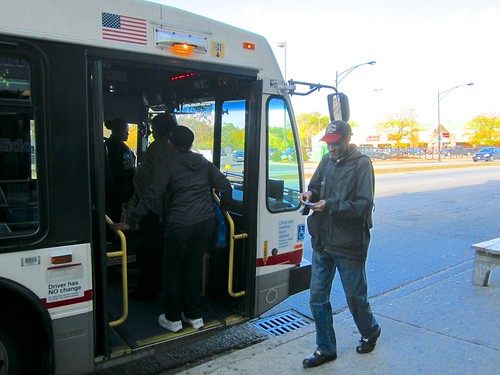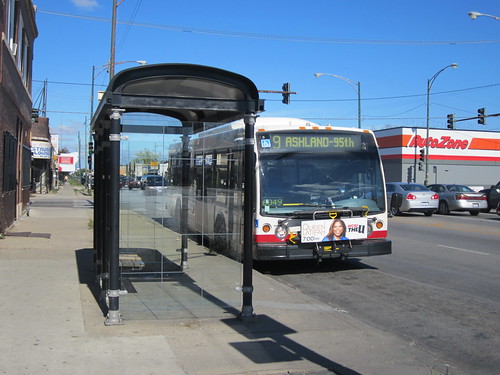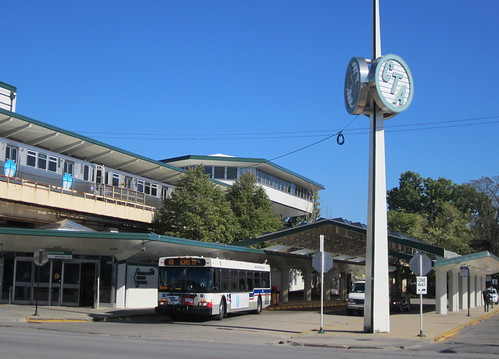[This piece also runs in Checkerboard City, John Greenfield's transportation column in Newcity magazine, which hits the street in print on Wednesday evenings.]
As I type this, it’s fourteen degrees in Chicago and snow is falling fast, but the battle over the future of Ashland Avenue is heating up. The city has put forth a bold plan to reconfigure the street by implementing bus rapid transit. Two of the four travel lanes will be converted to dedicated lanes for high-speed, center-running buses that will pick up passengers from platform stations in the median, providing an El train-like experience.
Scores of businesses and organizations, plus more than 2,500 individuals, have signed on to endorse the plan, and Alderman Ameya Pawar is an enthusiastic supporter, but there’s also fierce opposition. The Ashland-Western Coalition, an opposition group led by Roger Romanelli, is trying to kill the project, and they’ve received more than their fair share of mainstream media coverage. Aldermen George Cardenas and Scott Waguespack have also become outspoken naysayers.
But what do people who actually ride the #9 Ashland bus on a regular basis think of the proposal? In early October, my blogging partner Steven Vance and I set out to walk the entire planned BRT route, from 95th to Irving Park, buttonholing CTA customers along the way to get their take. Let’s return to that still-balmy Monday to see what they said.
We start our hike at 11am from the south end of the route in Brainerd, by the Third Baptist megachurch. At 71st we encounter Jihad Mahdi, thirty-four, waiting for the bus to take him to a grocery store on 95th. He says he’s opposed to changes that would slow down cars on Ashland, even though the plan to nearly double current bus speeds from 8.7 to 15.9 mph, including stops, would benefit him as a frequent transit rider. The CTA projects average car speeds on Ashland would only be reduced by ten percent, from 18.3 to 16.5 mph.
“I know it would get people to ride the bus more often but who wants to take the bus everywhere?” Mahdi says. However, once the system is built and the bus becomes nearly as fast as driving, minus the costs and headaches, folks like him are likely to understand the value.
At 63rd Street, we talk to Elizabeth Ware, a healthcare worker who’s transferring to the #9 from the Green Line. She rides the bus every day on her commute from her home in Englewood to her job in Bronzeville, and she’s seen notices onboard about BRT. “The impression that I get from the ads is that they’re trying to make the bus better and faster,” she says. I explain that the two center lanes of Ashland would be converted to car-free bus lanes. “Oh, that’s a good thing!” she exclaims.
We continue on through Back of the Yards, Bridgeport and Pilsen with relatively few encounters with riders, but we come across Mike Johnson, forty-four, waiting for the #9 at Roosevelt, by the Illinois Medical District. The IMD is one of the official supporters of the plan because they understand it will make it easier for staff, students and patients to get there.
Johnson, who’s coming from a doctor’s appointment and heading up to Ravenswood to get something to eat, is enthusiastic about BRT. “People need to get to their appointments and work,” he says. “If you gotta be down there at 95th, right now it takes you an hour and a half to get there from the North Side. That’s because you’ve got all this going on.” He gestures to the car-choked street behind him.

Since Steven is nine inches taller than me, his feet have been taking more of a beating, and he decides to bail at the Blue Line’s Division stop in Wicker Park. After he departs, I talk with a thirty-six-year-old accountant waiting for the bus at Polish Triangle. He commutes to the Loop every day from Lakeview via the #9 and the subway, but he’s skeptical that the $160 million BRT project will benefit him.
“It’s a lot of money for something that may or may not work,” he says. “You’ve got to have an exponentially larger number of people ride the bus to get enough cars off the road, so that the bus can actually move quicker.” However, when I explain that the buses will have their own lane so they won’t get stuck in traffic jams, he concedes that BRT will, in fact, speed his commute.
At about 8pm, I come to the northern terminus of the future BRT route at Irving Park. A #9 pulls up and Linda Carretero exits in a wheelchair. She commutes daily by bus from her home near Irving and Pulaski to her job at a clinic on the medical campus. Carretero tells me that BRT stations with platforms at the same level as the bus floor appeal to her, since she’d be able to roll right on. “The plan sounds interesting,” she says. “Hopefully they will have the kinks worked out before it launches, unlike the Ventra card.”
While responses to the project were a mixed bag, that didn’t come as a big surprise. Taking away space from cars and giving it to buses in order to move people through the city more efficiently is a concept that’s a little hard to wrap your head around. I was reminded of the answer I once got from Steve Schlickman, head of UIC’s Urban Transportation Center, when I asked what’s the best strategy for convincing people BRT is a good idea. “Doing it,” he said.








